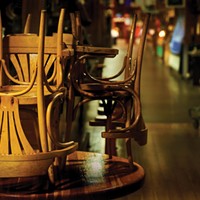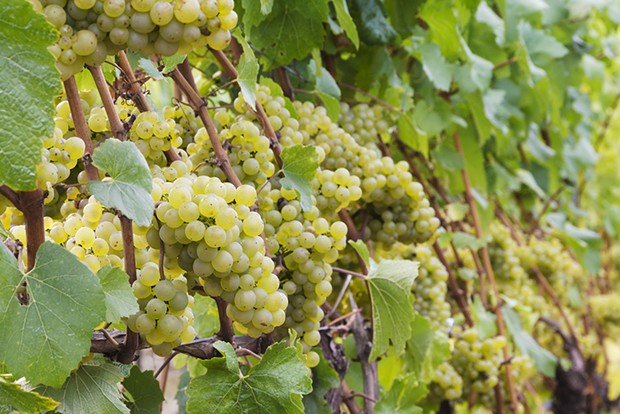A Pirate's Treasure of Chardonnays
From buttery to bright and even a little cave-y
[
{
"name": "Top Stories Video Pair",
"insertPoint": "7",
"component": "17087298",
"parentWrapperClass": "fdn-ads-inline-content-block",
"requiredCountToDisplay": "1"
}
]
Growing up, "wine" and "chardonnay" were synonymous in my house. The women in my family drank Wente chardonnay like they owned stock in the winery. It was the first wine I remember being allowed a sip of when I was young and it accompanied every family gathering once my mom decided I was old enough to drink. The only problem was that I didn't actually like it much. I also had nothing to compare it to, so I just figured that's what all wine tasted like and you just put up with it for the sake of getting drunk at family dinners.
But in my early 20s, I moved to Central Texas and stumbled into working at a fully estate winery. Soon after I was hired, my boss poured me a glass of white wine and asked me to describe it. I awkwardly swirled the wine in my glass, stuck my nose in and sniffed, fully prepared for it to smell a whole lot like wine and nothing else. But before I knew what was happening, I blurted out, "It smells like the Pirates of the Carribean ride at Disneyland."
As soon as I said it, I was sure it was the dumbest thing I had ever said in my life. This thought seemed to be confirmed by the look on my boss' face. Apparently, Texans aren't particularly familiar with Disneyland, let alone the nuances of the Pirates of the Carribean. After some discussion in which I described the ride, we discovered that what I was smelling was referred to as "wet stone."
When she told me the wine was a chardonnay, my mind was blown. How could this wine that smells like robot pirates in a wet cave possibly be in the same category as the apple-y, oaky Wente I had grown up with?
The answer is because wine is incredibly versatile. One grape can be produced in many different styles and none exemplify this more than chardonnay. Its popularity means that it's grown around the world and each location accents different flavor profiles. Chardonnay also responds particularly well to winemaking influences like oak, which broadens the possibilites of flavors and styles.
On the far ends of this flavor spectrum are France — specifically Chablis — and California. And as usual, I have scoured the town for examples of these two styles that you can go out and try today, as well as examples from local winemakers to compare and contrast to vastly different styles.
Chablis is a region in Burgundy, France, though geographically speaking it is closer to Champagne than it is to the rest of Burgundy. The cool, northern climate produces chardonnay that is crisp, and tart and the chalky soil adds a minerality that seems to electrify the finish of this mouth-watering white wine. Most Chablis are aged in stainless steel or neutral oak to preserve this clean, bright acidity, though some are starting to introduce new oak to the style. Now, I do feel the need to specify that I am not referring to the Chablis that comes in a box or a jug, but if that's what you're into, more power to you. However, you don't have to spend a fortune to get yourself a good or reasonable bottle.
Searching for one locally, I contacted NaRayan at Libation, my go-to for import wines. He has a couple of options but the one I ultimately chose was a 2018 Domaine Séginot-Bordet from Petit Chablis AOC, priced at $21. Though Petit Chablis is not the best appellation they've got, this particular wine is a good example of how light and crisp a chardonnay can be. It is refreshingly tart with notes of Granny Smith apple, honeysuckle, starfruit and lime peel, and finishes with a sharp minerality.
In stark contrast is the California style of chardonnay. To get the biggest possible contrast to Chablis, I chose Jam Cellars' 2017 Butter, which I picked up at Myrtlewood Liquors & John's Fine Cigars for $14.99. This wine is labeled as "Cellared and bottled by Jam Cellars - Lodi, California," which indicates that the grapes likely came from multiple vineyards and that the wine was not actually made on location at Jam Cellars. Regardless, the grapes being from California is the first clue that this wine is going to be very different. Central and Northern Central California have warm climates that allow grapes to ripen more than in a cool climate. On top of that, this wine has been oaked heavily and has gone through malolactic fermentation (a process that converts malic acid into lactic acid, creating a rich, buttery flavor and mouth-feel). This wine has notes of Red Delicious apple, vanilla, buttered popcorn and toast, with a richness that clings to the palette.
Personally, of the two styles, I usually prefer the light, bright acidity of Chablis. But along with giant scarves, bad horror movies and disgusting amounts of Halloween candy, I think there is no better way to embrace autumn than with a glass of apple-y, rich chardonnay. So here's what I'm drinking this fall from our local winemakers.
First is Septentrio, in part because I am head over heels for its new tasting room, but also because winemaker Jared Sandifer has multiple chardonnays that span the spectrum of flavors from crisp to buttery. Ultimately, the one that I went home with was a 2017 from Soda Canyon Creek Vineyard in Napa Valley for $26. Though not the same style as a Chablis, this wine does embody a more French style with bright acidity and a touch of warm coziness from having been aged in oak. With notes of caramel apple, pineapple, toasted coconut and apple blossoms, this wine is a perfect "best of both worlds" situation.
Second is Moonstone Crossing. Winemakers Don Bremm and Sharon Hanks have a couple of options, including one aged in stainless steel. But the one that stands out to me is the 2016 Russian River Valley chardonnay, which is $28 at their tasting room. If you're more into the buttery side of life, this wine is for you. With notes of fresh pressed apple cider, candied pineapple, buttered toast and toasted almonds, it's perfect for snuggling in for that horror movie marathon.
With as wide-ranging as the flavors and styles of chardonnay are, I encourage you to go out and taste more of them. In California it can be so easy to assume that all chardonnays are like Butter, Rombauer or Wente, but there are so many other beautiful wines made from this versatile grape. Let our local winemakers and shop owners guide you through tasting the many forms that chardonnay can take. Whether it's because it tastes like green apple, buttered popcorn or a pirate cave, there is likely a chardonnay out there for you.
Erin Young is a wine educator, consultant and Wine & Spirit Education Trust student. She prefers she/her pronouns and you can find out about her classes at the Wine Cellar via her Instagram @winewithyoung.
Speaking of...
-

Wildlife Emergency, Guns and Funky Wine
Sep 15, 2023 -

COVID-19 Cases Among Restaurant Staff Deliver Another Blow
Dec 10, 2020 -

NCJ Preview: Post-election Perspectives and Pandemic Wine Tasting
Nov 12, 2020 - More »
































